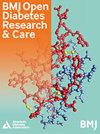通过对人体血浆蛋白质组进行孟德尔随机分析,揭示糖尿病引发的肩周炎的潜在治疗靶点
IF 3.7
2区 医学
Q2 ENDOCRINOLOGY & METABOLISM
引用次数: 0
摘要
引言 本研究旨在通过孟德尔随机化(MR)方法研究人体血浆蛋白质组中与糖尿病和肩周炎相关的靶蛋白,从而评估糖尿病和肩周炎之间的因果关系,并揭示相应的病理机制。研究设计与方法 我们采用孟德尔随机化方法来确定:(1) 糖尿病与肩周炎之间的因果关系;(2) 与肩周炎相关的血浆因果蛋白;(3) 与糖尿病相关的血浆靶蛋白;(4) 糖尿病靶蛋白与肩周炎因果蛋白之间的因果关系。通过共定位分析和蛋白质相互作用网络对磁共振结果进行了验证和整合。结果 我们的磁共振分析表明,糖尿病与肩周炎之间存在显著的因果关系。我们发现,在 Bonferroni 显著性水平(P<3.03E-5)下,四种蛋白质的血浆水平与肩周炎相关。根据共定位分析,甲状旁腺激素相关蛋白(PTHLH)与肩周炎的遗传变异中度相关(后验概率=0.68),而分泌型脆裂相关蛋白4与肩周炎的遗传变异高度相关(后验概率=0.97)。此外,九种血浆蛋白在糖尿病相关病理过程中被激活。随后对九种糖尿病靶蛋白和四种肩周炎致病蛋白进行的磁共振分析表明,胰岛素受体亚基α、白细胞介素-6受体亚基α、白细胞介素-1受体附属蛋白、谷胱甘肽过氧化物酶7和PTHLH可能是糖尿病诱发肩周炎发病和进展的原因。结论 我们的研究确定了糖尿病与肩周炎之间的因果关系,强调了糖尿病影响肩周炎的病理途径。数据可在公开、开放的资料库中获取。所有与研究相关的数据均包含在文章中或作为补充信息上传。本文章由计算机程序翻译,如有差异,请以英文原文为准。
Unveiling potential therapeutic targets for diabetes-induced frozen shoulder through Mendelian randomization analysis of the human plasma proteome
Introduction This study aimed to assess the causal relationship between diabetes and frozen shoulder by investigating the target proteins associated with diabetes and frozen shoulder in the human plasma proteome through Mendelian randomization (MR) and to reveal the corresponding pathological mechanisms. Research design and methods We employed the MR approach for the purposes of establishing: (1) the causal link between diabetes and frozen shoulder; (2) the plasma causal proteins associated with frozen shoulder; (3) the plasma target proteins associated with diabetes; and (4) the causal relationship between diabetes target proteins and frozen shoulder causal proteins. The MR results were validated and consolidated through colocalization analysis and protein–protein interaction network. Results Our MR analysis demonstrated a significant causal relationship between diabetes and frozen shoulder. We found that the plasma levels of four proteins were correlated with frozen shoulder at the Bonferroni significance level (p<3.03E-5). According to colocalization analysis, parathyroid hormone-related protein (PTHLH) was moderately correlated with the genetic variance of frozen shoulder (posterior probability=0.68), while secreted frizzled-related protein 4 was highly correlated with the genetic variance of frozen shoulder (posterior probability=0.97). Additionally, nine plasma proteins were activated during diabetes-associated pathologies. Subsequent MR analysis of nine diabetic target proteins with four frozen shoulder causal proteins indicated that insulin receptor subunit alpha, interleukin-6 receptor subunit alpha, interleukin-1 receptor accessory protein, glutathione peroxidase 7, and PTHLH might contribute to the onset and progression of frozen shoulder induced by diabetes. Conclusions Our study identified a causal relationship between diabetes and frozen shoulder, highlighting the pathological pathways through which diabetes influences frozen shoulder. Data are available in a public, open access repository. All data relevant to the study are included in the article or uploaded as supplementary information.
求助全文
通过发布文献求助,成功后即可免费获取论文全文。
去求助
来源期刊

BMJ Open Diabetes Research & Care
Medicine-Endocrinology, Diabetes and Metabolism
CiteScore
9.30
自引率
2.40%
发文量
123
审稿时长
18 weeks
期刊介绍:
BMJ Open Diabetes Research & Care is an open access journal committed to publishing high-quality, basic and clinical research articles regarding type 1 and type 2 diabetes, and associated complications. Only original content will be accepted, and submissions are subject to rigorous peer review to ensure the publication of
high-quality — and evidence-based — original research articles.
 求助内容:
求助内容: 应助结果提醒方式:
应助结果提醒方式:


